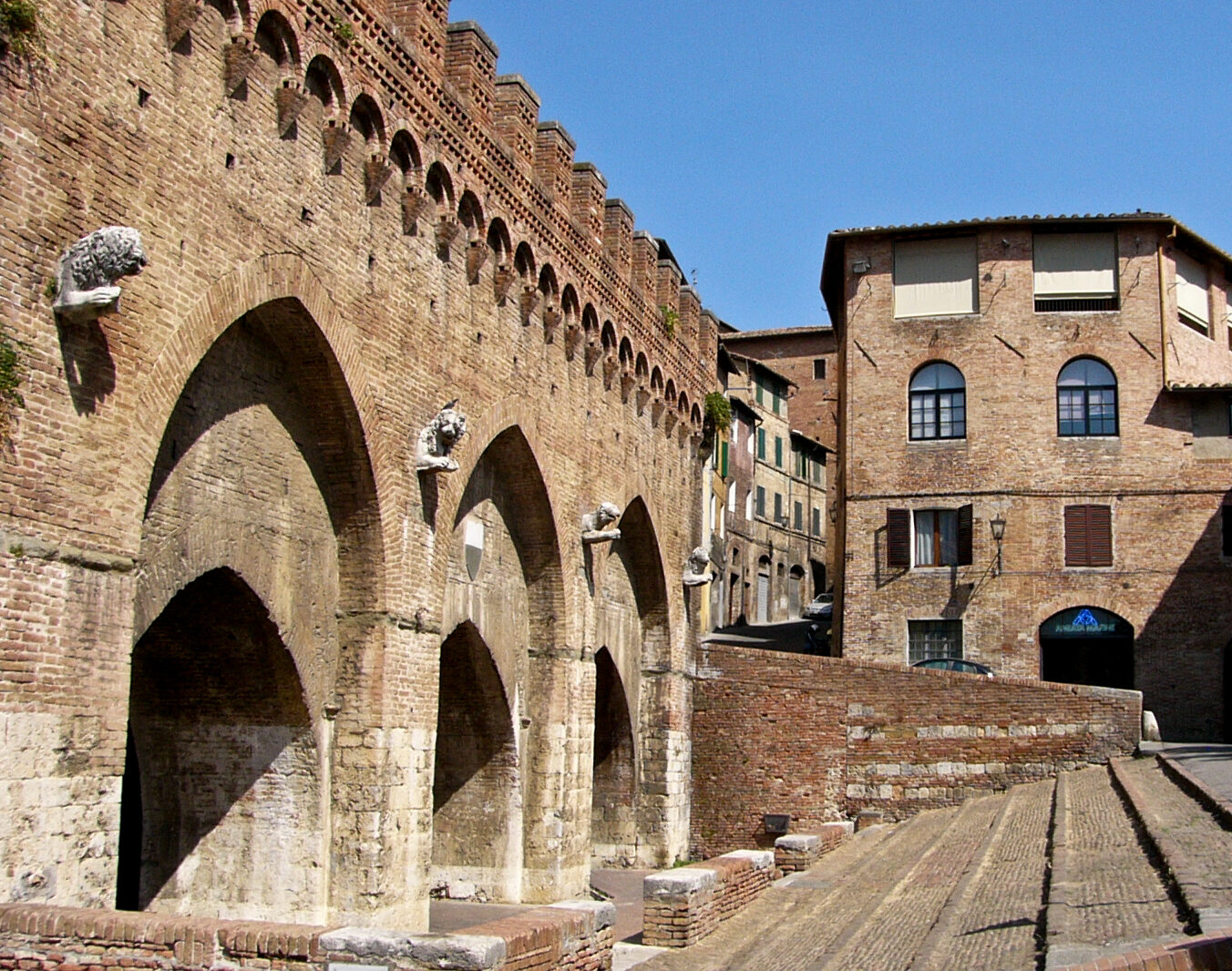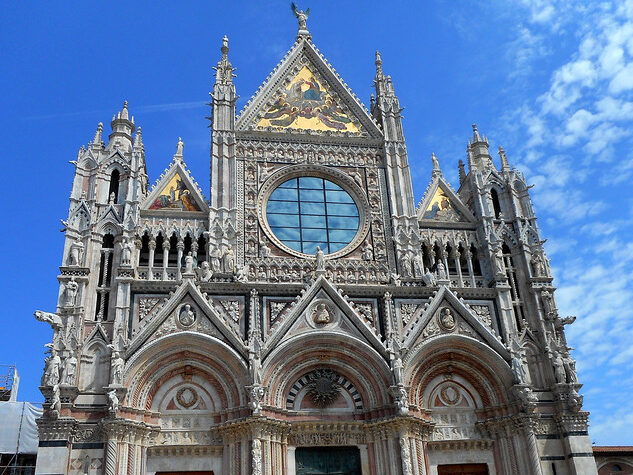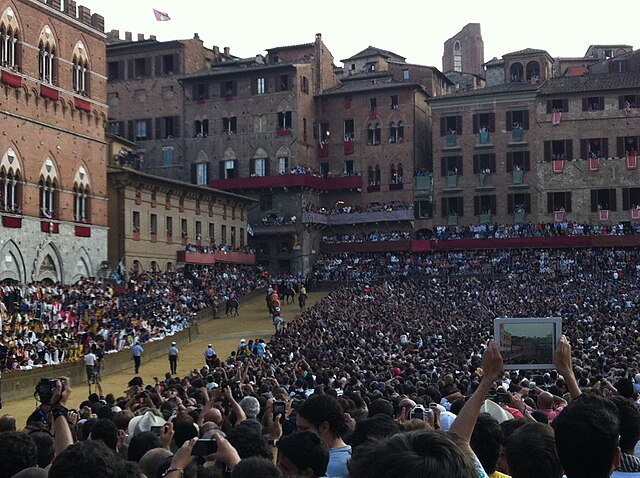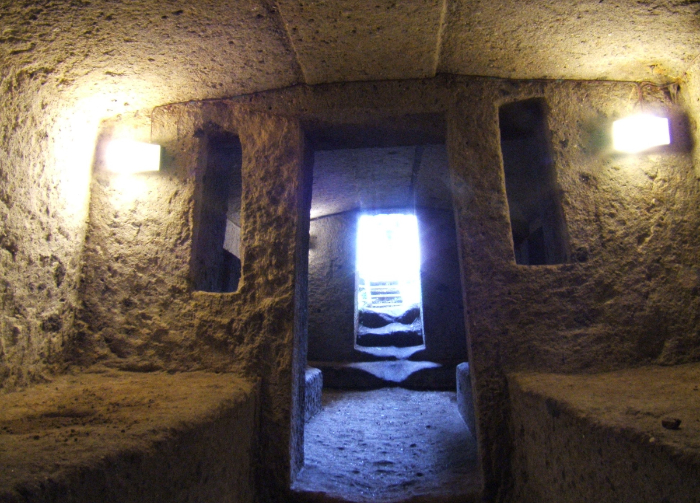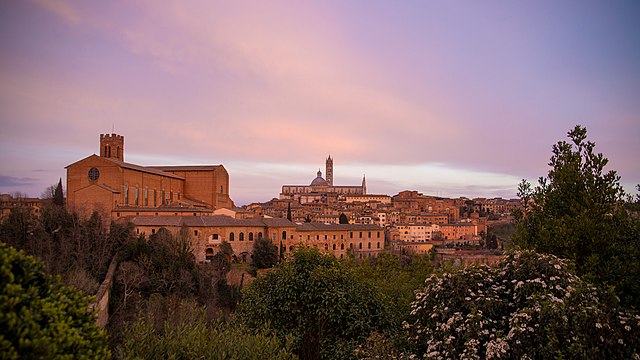Architecture of Siena, Tuscany, Italy
UNESCO Sites in Siena: Siena Historic Center
Must-See Sites in Siena: Siena Cathedral, Piazza Del Campo, Palazzo Pubblico
Although Siena isn’t one of the largest cities in Italy, it makes up for its smaller size with its incredible buildings, squares, and streets. Siena is a great example of a Tuscan Hill Town. Although similar to many other towns in the surrounding area, Siena stands out thanks to its impressive works of architecture. The city contains several iconic structures dating from the 12th to 16th centuries, all built during the peak of the powerful Republic of Siena. Today most of Siena’s historic buildings remain intact, and the city is known for having one of the best-preserved Medieval Centers in all of Europe.
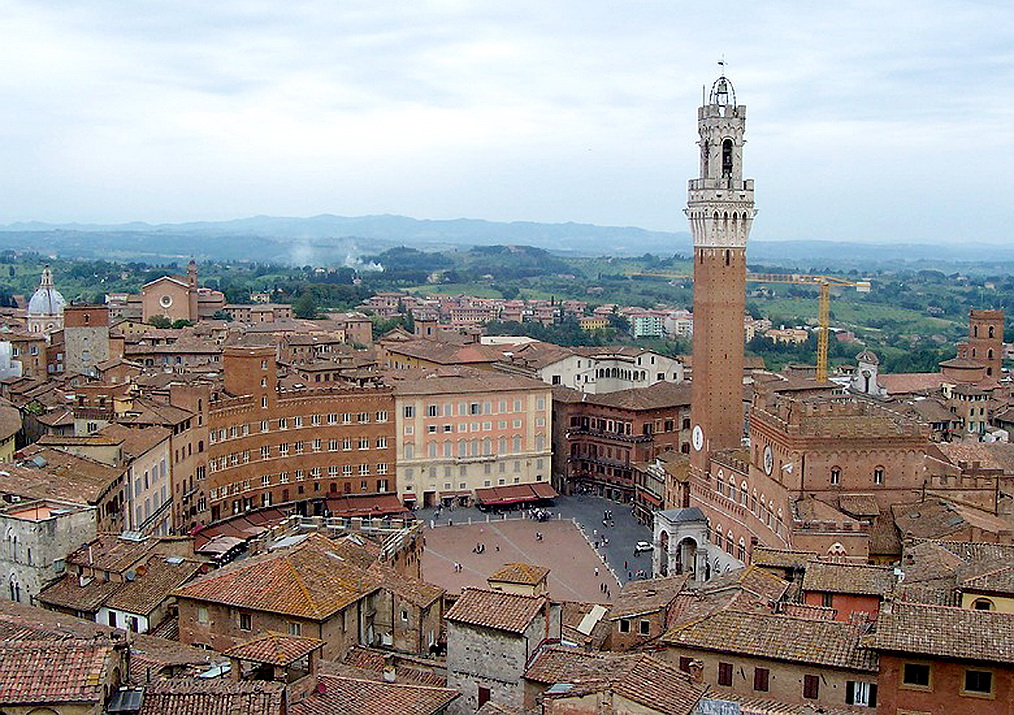
Map of Siena
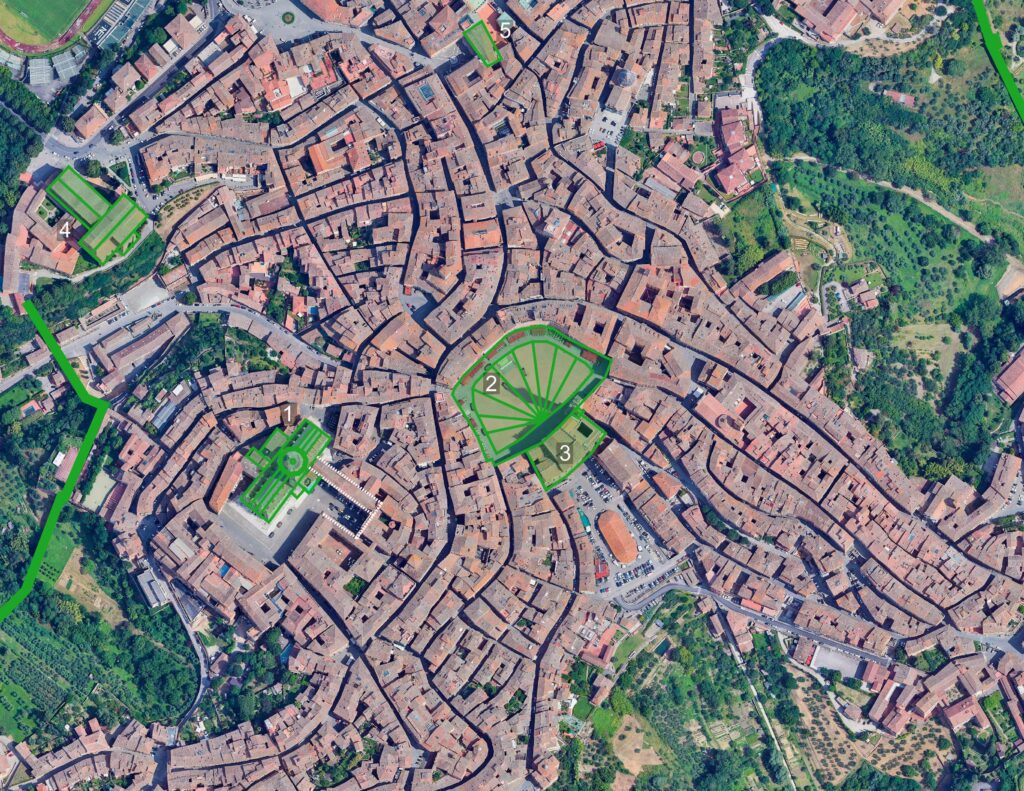
Map of Siena highlighting some of the city’s main attractions.
1. Siena Cathedral
2. Piazza Del Campo
3. Palazzo Pubblico
4. Basilica of San Domenico
5. Palazzo Salimbeni
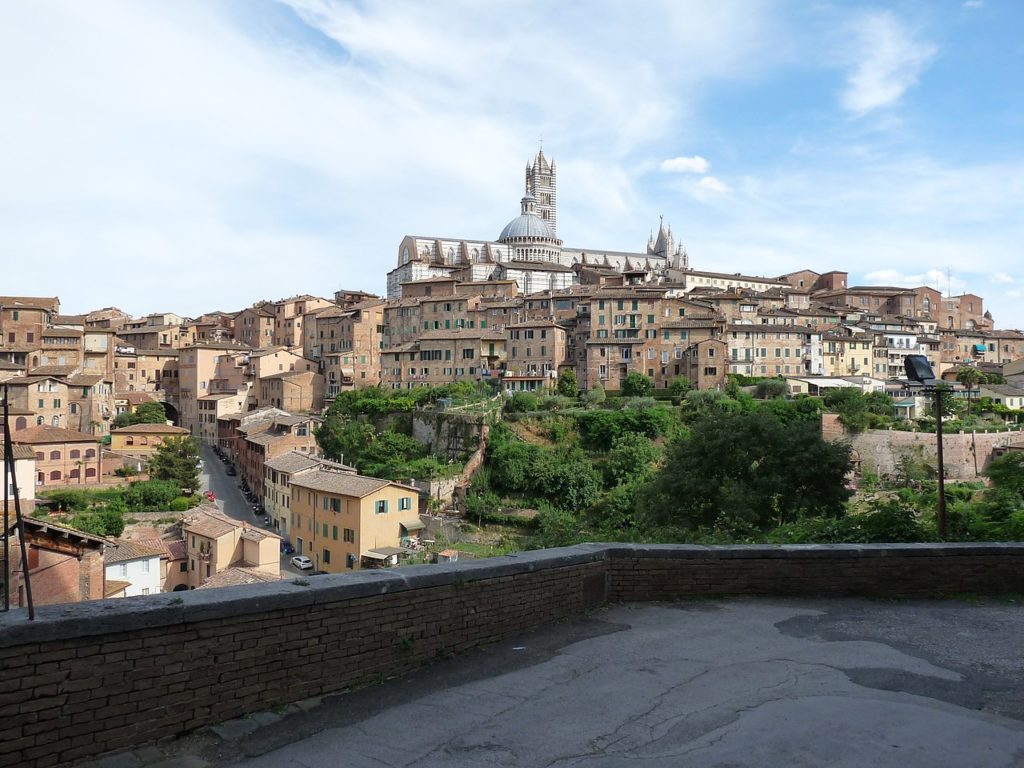
Table of Contents
History of Siena
Unifying Elements in the Architecture of Siena
Red Bricks

The majority of Siena’s historic buildings are made from one particular type of brick. These bricks, which have a dark-reddish color, are the most unifying element of the architecture of Siena. Even the popular crayon company Crayola includes a shade of red known as “Burnt Sienna” in certain packs of its crayons.
A lack of modern structures
Photo by Yannick from Wikimedia Commons

Siena went from being a prominent and fast-growing city-state in the early Middle Ages, to a smaller provincial capital within the Grand Duchy of Tuscany by the 1700s. As a result of this decline, there is little architecture in Siena from after that time. Siena’s lack of modern structures makes it an incredible destination, and it is world-renowned as one of Europe’s best-preserved cities.
Gothic and Romanesque Architecture in Siena
Siena reached its peak during the Middle Ages. It became a self-governing city-state in the 12th century, and would eventually be the capital of a large territory known as the Republic of Siena. Siena was a hub for banking and finance, and its wealthy citizens commissioned large palaces and other impressive projects. Many of the buildings from this period were designed in the Gothic Style and feature typical Gothic elements like Spires, Pinnacles, and Pointed Arches.
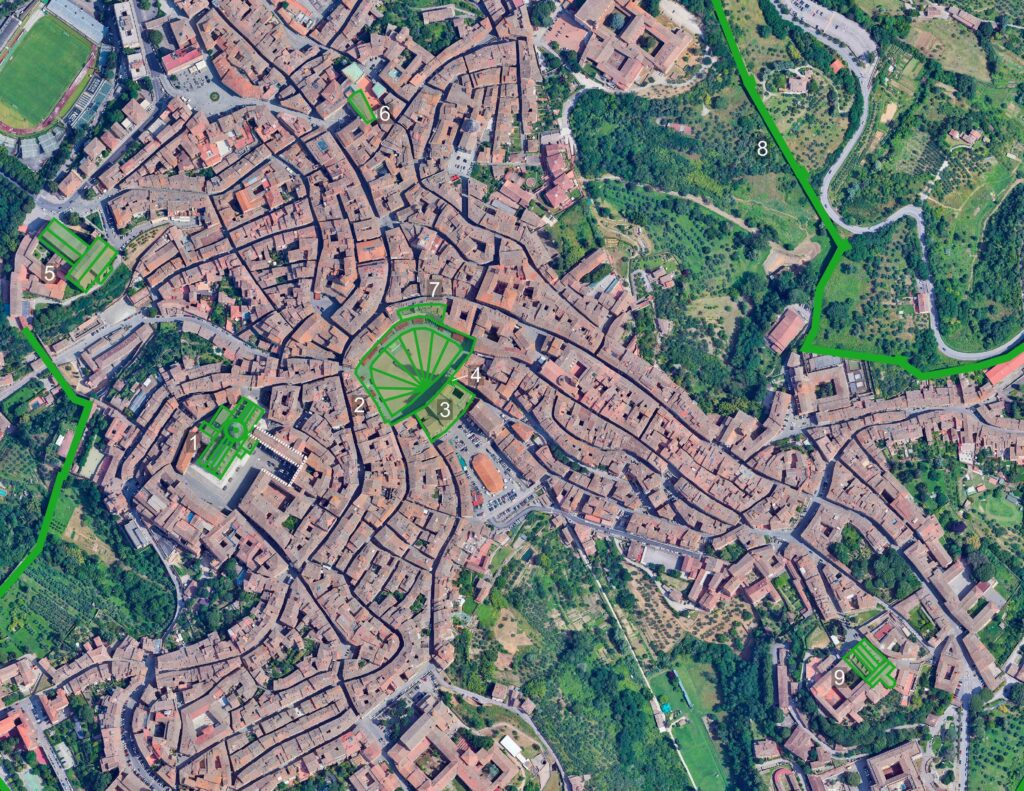
Map of Siena highlighting the most notable works of Gothic and Romanesque Architecture within the city.
1. Siena Cathedral (Duomo di Siena)
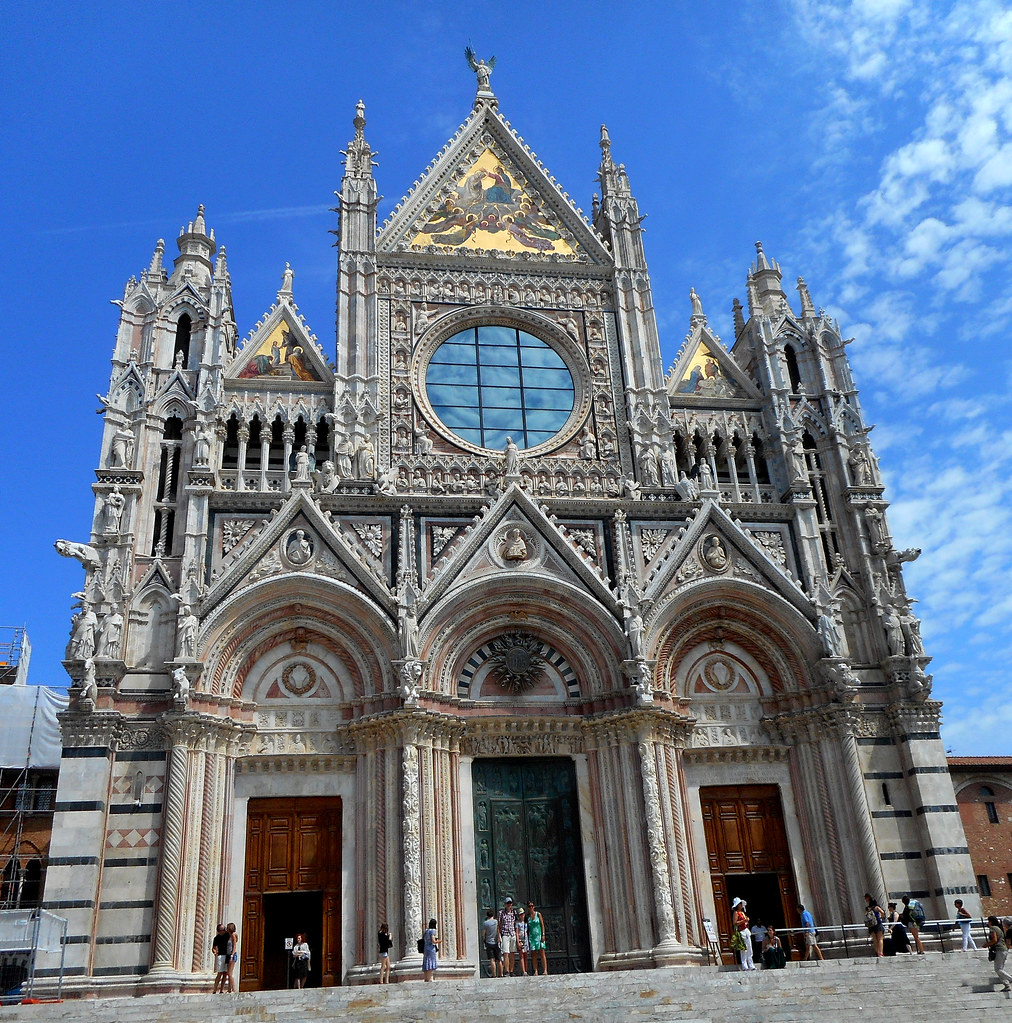

Siena Cathedral is a large work of Gothic Architecture that dominates the city’s skyline. It was originally planned to be much larger. City officials wanted to build one of the largest churches in all of Italy – in an effort to compete with nearby Florence. However, a plague and several military defeats forced plans for the massive cathedral to be significantly scaled back. Despite these last-minute design changes, Siena Cathedral remains an incredible building that’s filled with amazing works of art.

The image above shows some of the incomplete portions of Siena Cathedral. To the right, you can see some large arches that were supposed to be part of the church’s nave. These remnants give you a sense of the overall size of the ambitious project. The materials used in the church also show the wealth and power of the Republic of Siena at this point in history. Siena Cathedral uses a blend of different marbles, all imported from various parts of the Italian Penninsula,
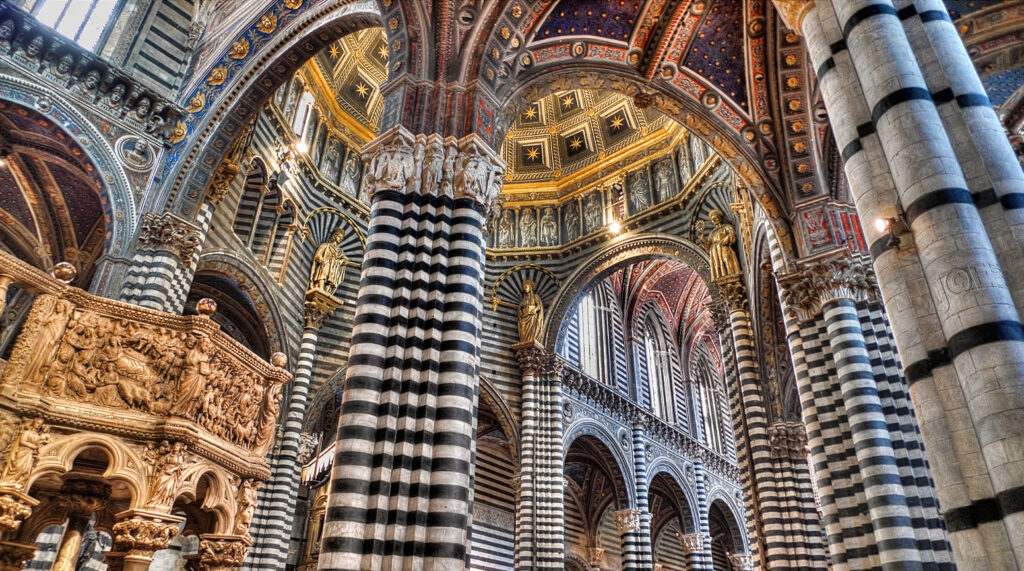
The interior of Siena Cathedral is outfitted with countless impressive works of architecture from the Gothic and Renaissance ages. The church contains a famous 13th-century pulpit designed by Italian sculptor Nicola Pisano. There is also a bronze statue by Donatello, and several frescoes and stained glass pieces throughout the building. Siena Cathedral is one of the city’s most impressive buildings, and along with several other structures it’s protected as part of a UNESCO World Heritage Site.
2. Piazza Del Campo

Siena is also home to one of the most well-known public spaces in the entire world: Piazza Del Campo. The site began as a large market square centered between several densely populated neighborhoods. The area had a gentle slope thanks to Siena’s natural topography. In the mid-1300s the entire piazza was paved over with bricks, and ever since it has served as the city’s most important gathering place. Today Piazza del Campo is home to many lively bars and restaurants, and it remains the key cultural hub within modern-day Siena.

Piazza del Campo is composed of nine triangular sections that all connect at one point. Each triangle slopes downward at a gentle decline, creating a surface that’s great for sitting comfortably. This approachability is what makes the piazza so successful. It’s no wonder why many modern urban planners still utilize these same elements in contemporary designs. Piazza del Campo is also surrounded by several of Siena’s most impressive works of architecture such as the Palazzo Pubblico, the Torre del Mangia, and the Fonte Gaia.
3. Palazzo Pubblico
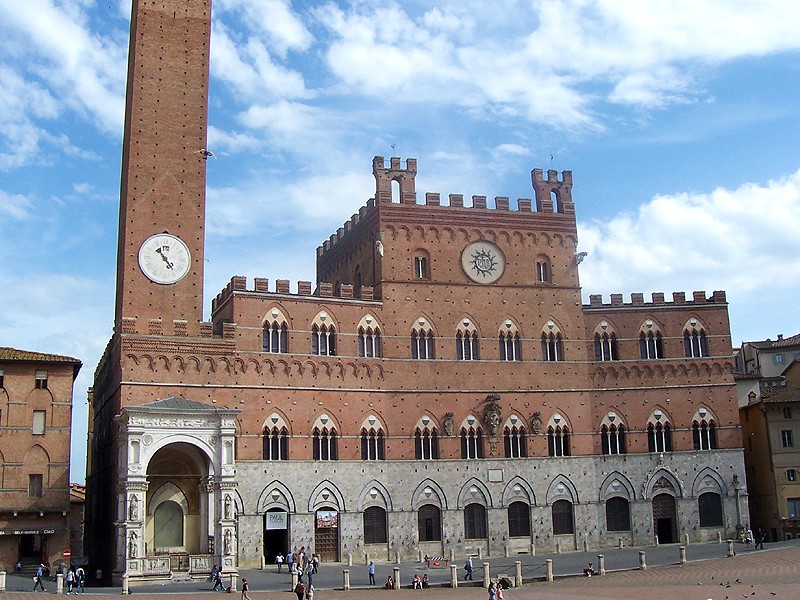
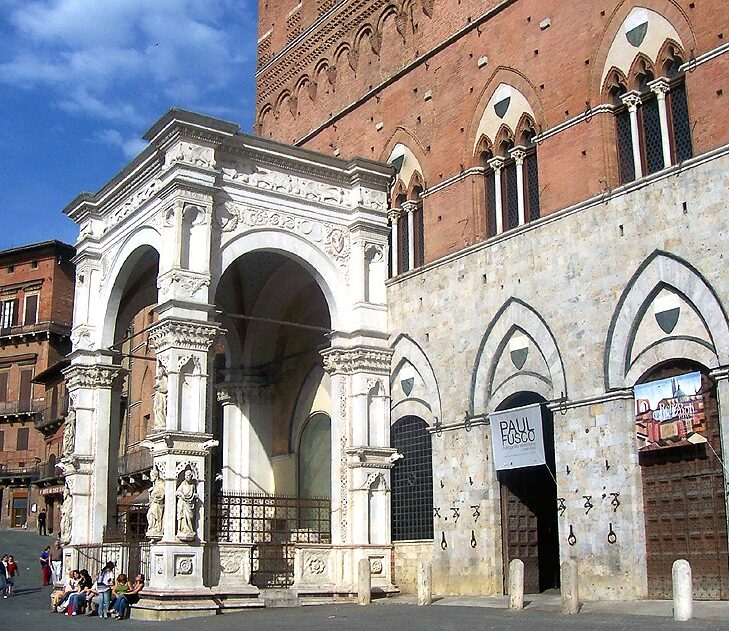
The Palazzo Pubblico, or “town hall.” was constructed as the seat of the Sienese Government. The Sienese leaders wanted to create an edifice that emphasized the capability and efficiency of the local government. Construction began on Palazzo Pubblico in 1297, and it features several typical elements from Gothic Architecture. Palazzo Pubblico sits at the lowest side of the Piazza del Campo, and it roughly marks the center of Siena’s historic core.
4. Torre Del Mangia
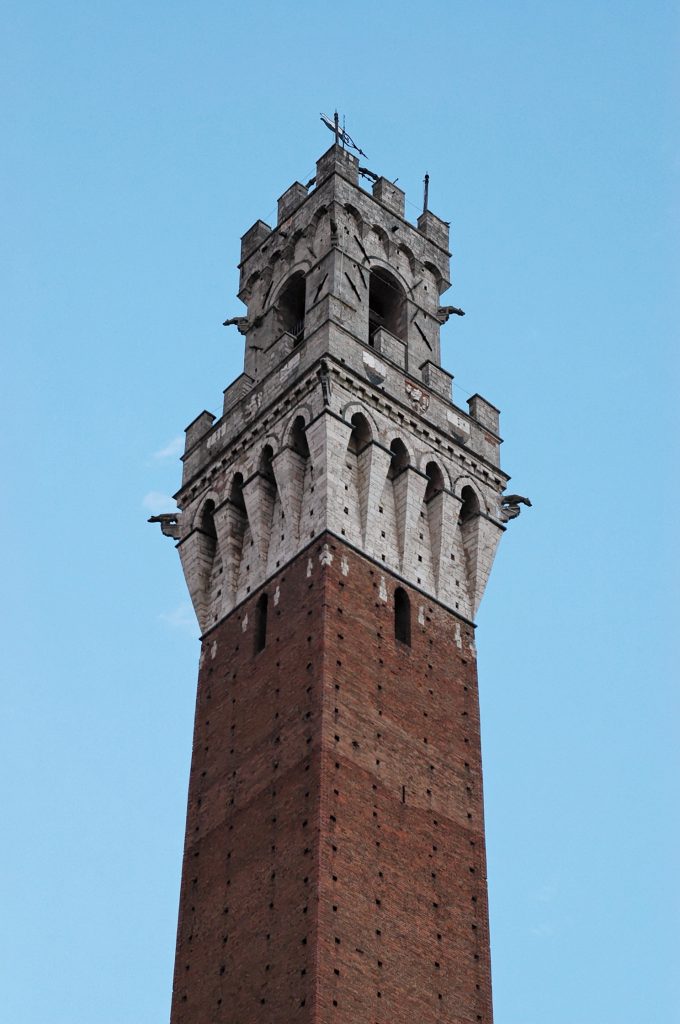
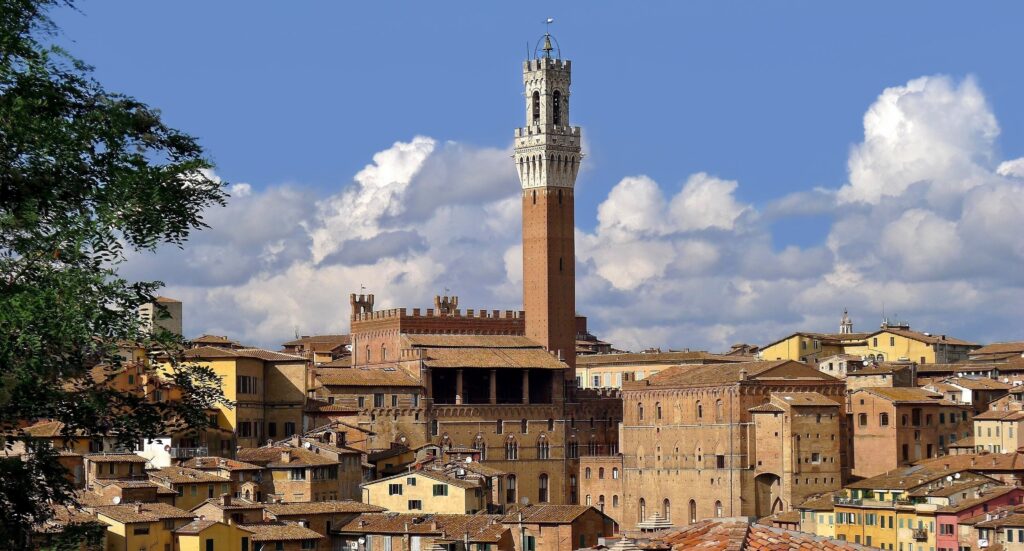
The Palazzo Pubblico also has a very distinct clock tower that overlooks the entire Piazza Del Campo. At the time of its completion in 1344, it was the tallest tower in all of Italy. Today, the Torre del Mangia is one of the most distinct landmarks in the entire city. In fact, its design has been replicated all over the world. Particularly in works of Renaissance Revival Architecture in the UK and USA.
5. Basilica of San Domenico
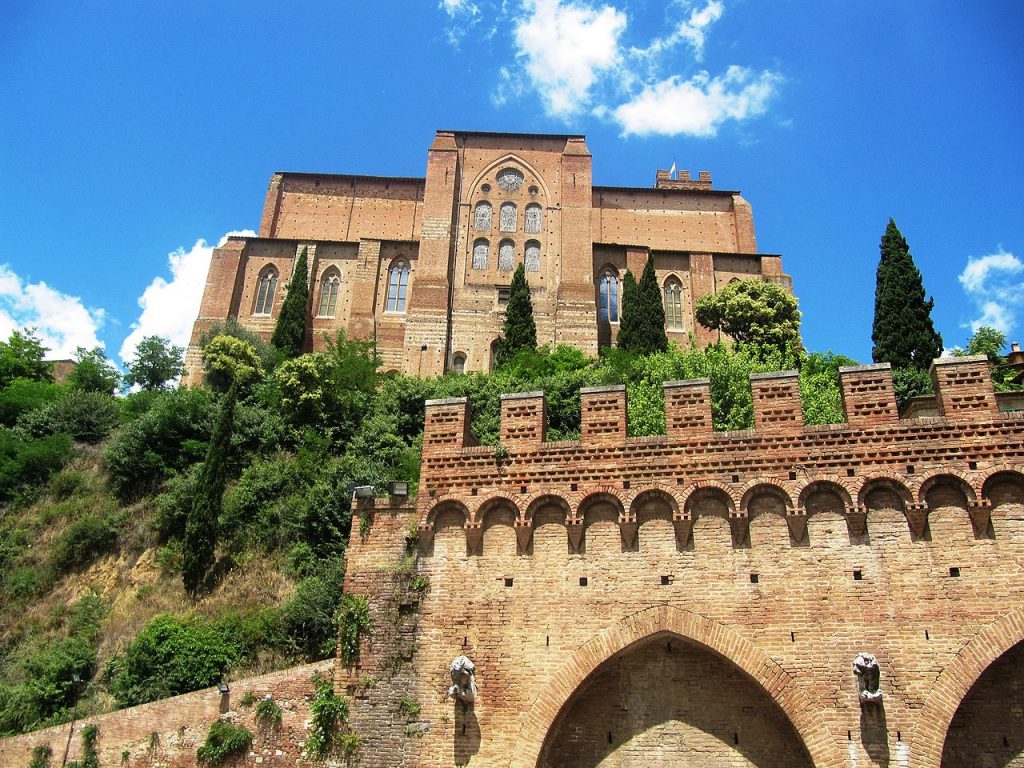
The Republic of Siena also built many fantastic works of religious architecture. Constructed in the 13th century, the Basilica of San Domenico is one of the largest churches in the entire city. Its exterior is made from typical Red Sianese Bricks, and the church sits atop one of Siena’s many hills, The building is a great example of Gothic Architecture, and it contains pointed arches, stained glass, and many other Gothic design elements,

Gothic was the dominant architectural style in Europe during the early Middle Ages. Check out our article on the Top 25 Examples of Gothic Architecture to learn more!
6. Palazzo Salimbeni

Trade flourished in the Republic of Siena, and as a result, the city was home to many wealthy noble families. These noble families built lavish palaces throughout the city, many of which date to the Gothic period. Palazzo Salimbeni is one of Siena’s most notable palaces. It was completed in the 1300s and faces a small square five minutes north of Piazza Del Campo. The facade of Palazzo Salimbeni was heavily restored in the 19th century, and it was outfitted with many Gothic Revival design elements.
7. Palazzo Sansedoni
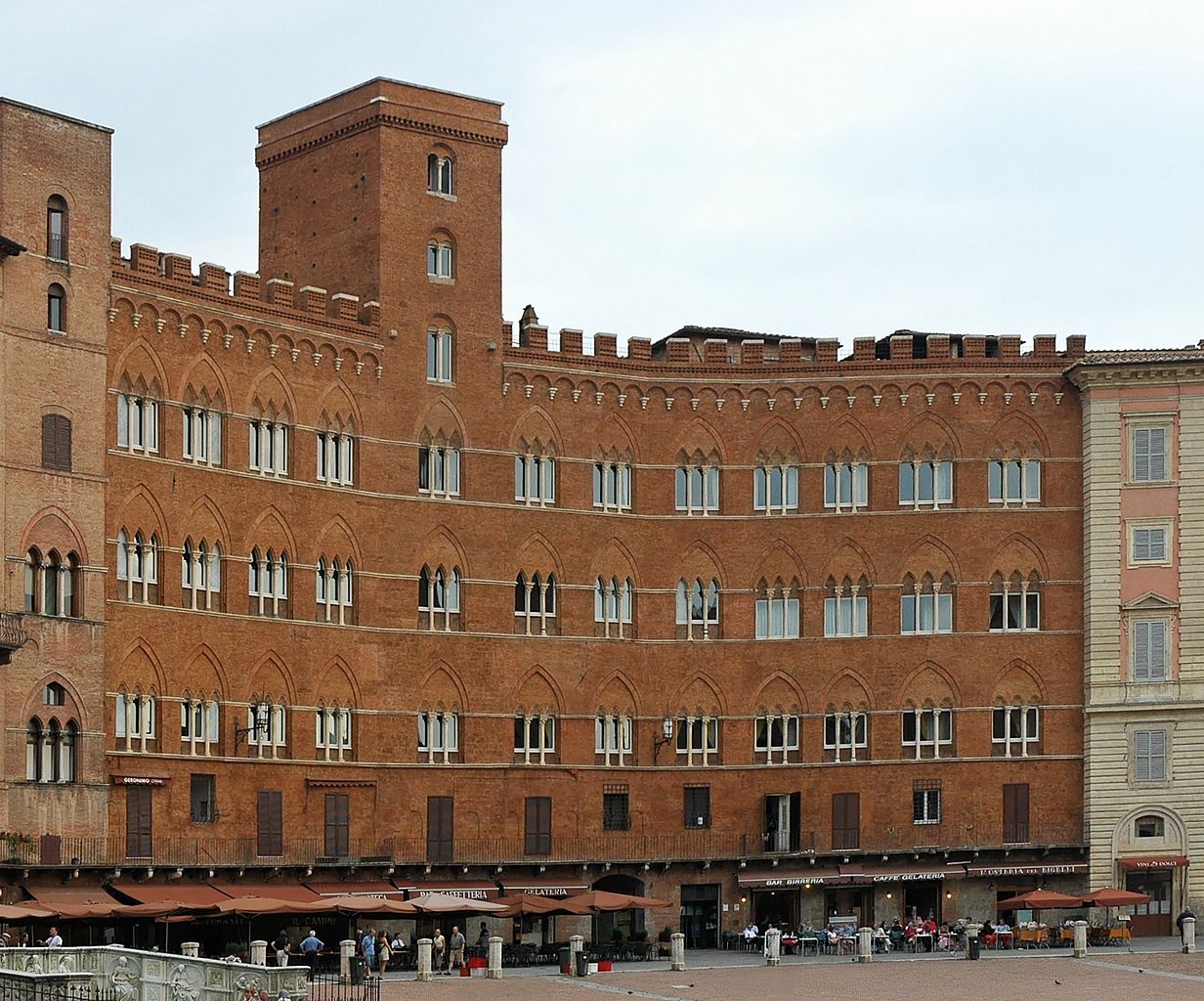
Palazzo Sansedoni is another great example of Gothic Architecture in Siena. Its exterior is completely made from the reddish bricks that can be found throughout the city. The building is famous because it faces the Piazza Del Campo, and today the first floor is filled with some of Siena’s most popular restaurants. Like many structures throughout Siena, Palazzo Sansedoni has seen several major restoration projects in the 21st century. City officials work hard to ensure that buildings maintain their original medieval appearance, which helps Siena maintain its status as a UNESCO World Heritage Site.
8. Siena’s Fortifications
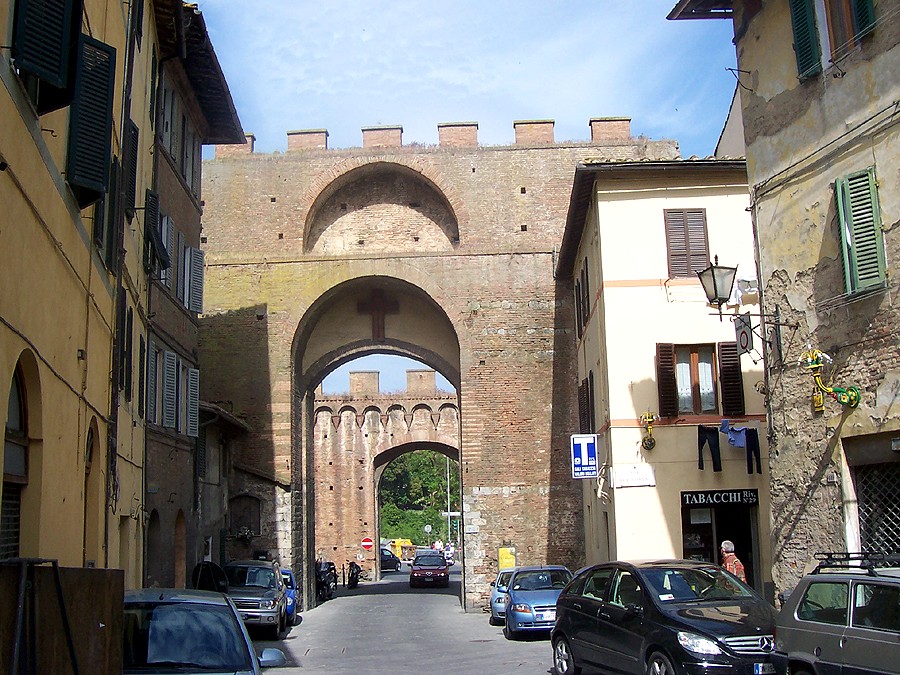

Siena was completely enclosed in a series of defensive walls during the Middle Ages. They protected the city from invasion and helped the Republic of Siena thrive for centuries. Although parts of the walls were demolished over time to make way for modern buildings, much of Siena’s fortifications have survived. The original fortified gates of these walls can still be seen along the city’s roadways. All of these gates utilize typical Sienese bricks, and feature elements found in Medieval Fortifications.
9. Santa Maria dei Servi
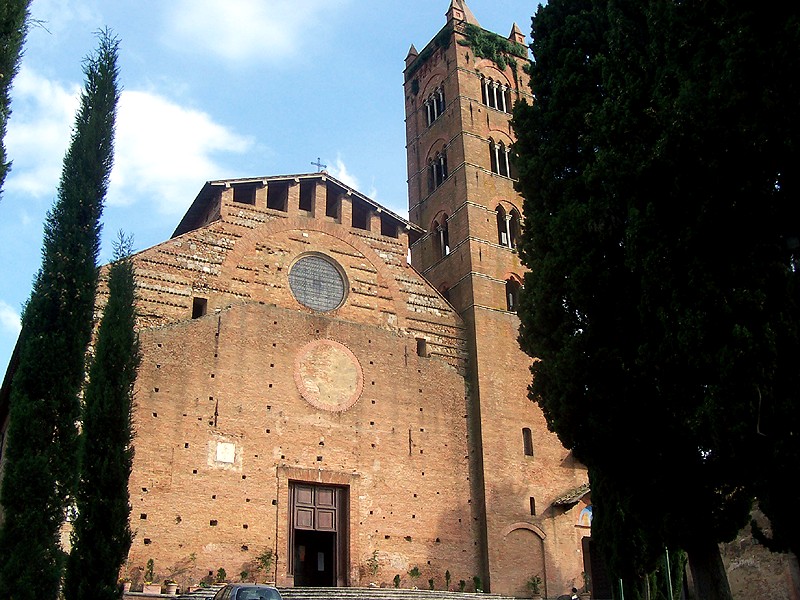
The Church of Santa Maria dei Servi is one of Siena’s most impressive works of Romanesque Architecture. Romanesque Architecture predates Gothic Architecture, and it was popular throughout Europe from the 10th-13th centuries. Romanesque buildings typically feature round arches, simplified forms, and small windows. Santa Maria dei Servi is located in the southeastern corner of Siena’s city center, and it sits atop a hill overlooking a large expanse of the Tuscan countryside.

Romanesque was Europe’s dominant architectural style from the 10th-11th century. Read our article, “Romanesque Architecture and the Top 15 Romanesque Buildings” to learn more!
Like Architecture of Cities? Sign up for our mailing list to get updates on our latest articles and other information related to Architectural History.
Renaissance and Baroque Architecture in Siena
The Republic of Siena would continue to thrive during the early stages of the Italian Renaissance. However, the city quickly became overshadowed by its larger neighbor, Florence. Siena was eventually defeated in battle by the Florentines during the mid-1500s, and by the Baroque Age, it was a less significant part of the larger Grand Duchy of Tuscany. Siena still contains a decent amount of Renaissance and Baroque Architecture, and these newer structures blend seamlessly with the older works of Gothic Architecture from the peak of the Republic of Siena.

Map of Siena highlighting the most notable works of Renaissance & Baroque Architecture within the city.
1. Piccolomini Library

Located within the grounds of Siena Cathedral, the Piccolomini Library is an impressive work of Renaissance Architecture in Siena. It’s covered by dozens of intricate frescoes that are attributed to the artist Pinturicchio. Pinturicchio previously worked in Rome, but would later move to Siena where he began work on the library in 1502. The frescoes are renowned as some of the greatest paintings in Siena. They utilize imagery, techniques, and characteristics that were common during the early stages of the Renaissance.
2. Fortezza Medicea

The Medici were a wealthy banking family that ruled over Florence and the entire Grand Duchy of Tuscany. They financed the construction of the Fortezza Medicea in 1561. This was done in an effort to bolster Siena’s defenses, but also to help keep the city under Florentine rule. Fortezza Medicea was constructed after the adaptation of gunpowder and was therefore built with low and thick walls. These were meant to absorb cannon fire and help protect soldiers and supplies inside the fort. Fortezza Medicea was part of a large network of fortifications, and similar forts can be found in nearby cities like Florence, Lucca, and Volterra.
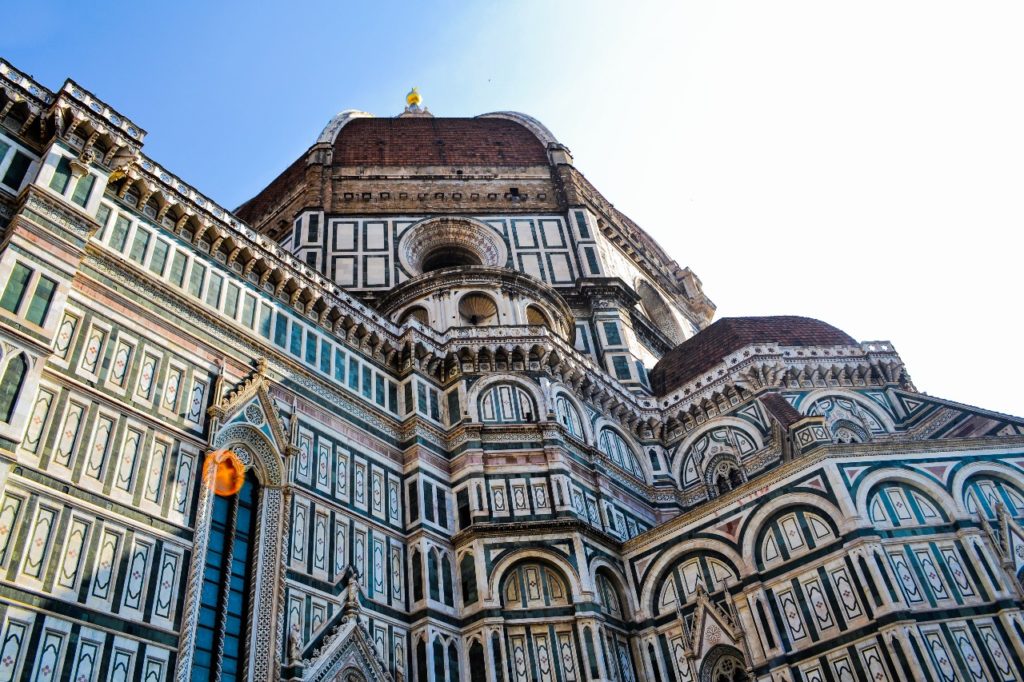
Interested in Renaissance Architecture? Check out our article on the Architecture of Florence to learn more about the Birth of the Renaissance Movement.
3. Fonte Gaia
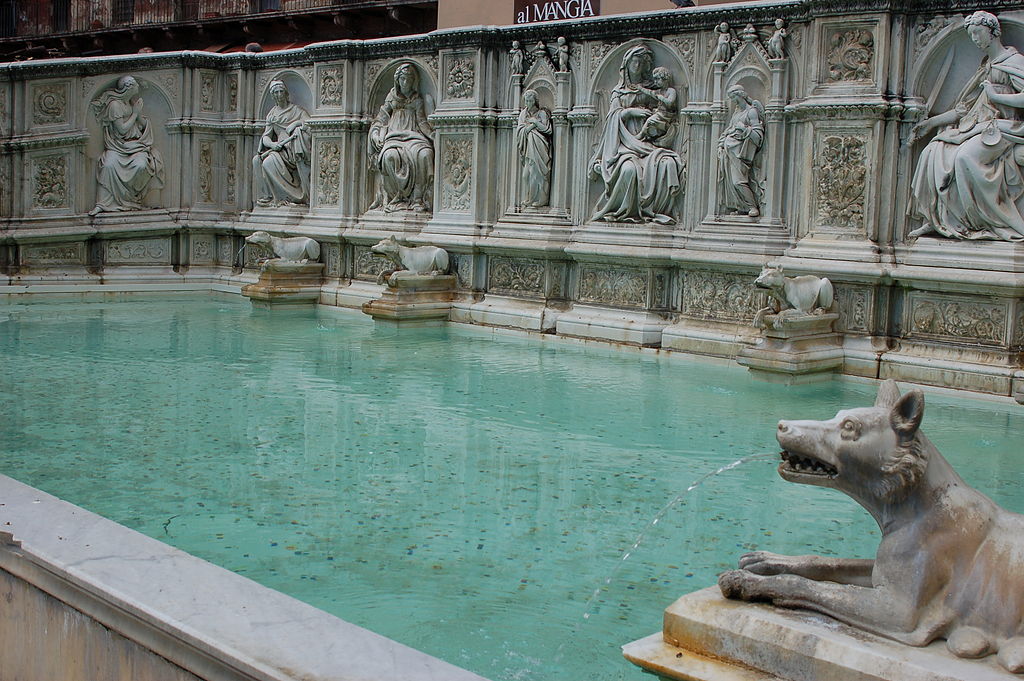
The Fonte Gaia is an early Renaissance sculpture that was completed in 1419. It utilizes many of the elements found in Renaissance Architecture, like symmetry, balance, and proportion. The fountain sits within Piazza Del Campo, and it’s a great example of the public art projects that were common in the Republic of Siena. The fountain contains an assortment of marble statues depicting elements from Christianity and everyday objects like plants, food, and animals. In the mid-19th century, most of the original artworks were replaced with exact replicas. The originals were moved to a nearby museum to protect them from erosion.
4. Santa Maria in Provenzano

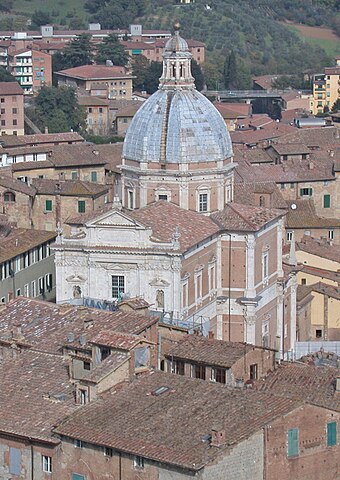
Santa Maria in Provenzano is an Early-Baroque church located in Siena’s historic center. It was completed in 1611 and it features many of the typical features in Baroque Architecture. The facade is embellished with many sculptural elements, and it contains several elliptical geometries. The church is also outfitted with a large dome that can be seen throughout Siena. Santa Maria in Provenzano’s interior features several notable works of Renaissance and Baroque art, and the church still holds regular services today.
Modern Siena
Today Siena has one of the most well-preserved historic cores of any European City. Many of the city’s streets and piazzas look the same as they did during the Middle Ages. The local government has issued many rules and regulations to help preserve Siena, and today it remains a popular tourist attraction thanks to its unique character. Modern Day Siena is void of any contemporary architecture, and thanks to its preservation efforts, it will remain a hotspot for medieval and Gothic Architecture for centuries to come.

Modern-day Siena is also famous for an event that takes place twice each year: The Palio di Siena. The Palio is a horse race that is housed within the Piazza Del Campo. Thousands of people flock to Siena for the Race, and the piazza is always packed tight with as many spectators as can fit. Although the race only lasts a moment, the following celebration lasts long into the evening.

Architecture of Siena: In Review
Although smaller and less well-known than nearby Florence, Siena is one of the most impressive and beautiful cities in all of Italy. It’s home to several world-renowned works of architecture and urban planning such as the Piazza del Campo, and the Palazzo Pubblico, and its entire historic center has remained remarkably well-preserved. Siena’s architecture remains very influential, and many modern-day designers still study the city and its buildings. Anyone who visits Tuscany should make their way to Siena, and those who do will be delighted by its historic medieval charm and its extraordinary works of architecture.
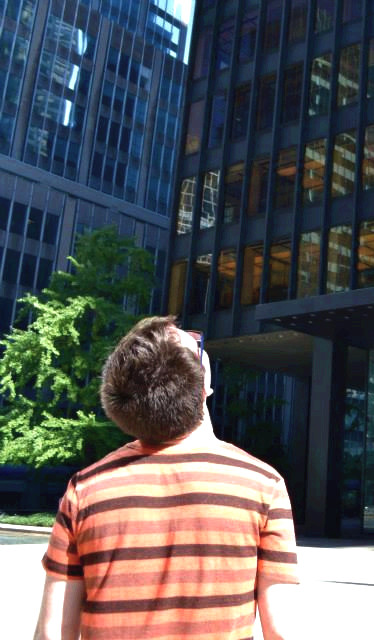
- About the Author
- Rob Carney, the founder and lead writer for Architecture of Cities has been studying the history of architecture for over 15 years.
- He is an avid traveler and photographer, and he is passionate about buildings and building history.
- Rob has a B.S. and a Master’s degree in Architecture and has worked as an architect and engineer in the Boston area for 10 years.
Like Architecture of Cities? Sign up for our mailing list to get updates on our latest articles and other information related to Architectural History.


